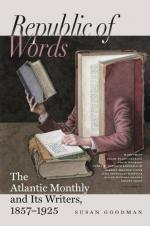In the first place, is to be found the limit of the palette. Confining ourselves to the external, what, of all the infinitude of phenomena to which the vision is related, so corresponds to the power of the palette that it may become adequately representative thereof?
Passing over many minor points in which there seems to be an imperfect relation between Nature’s effects and those of pigments, we will briefly refer to the great discrepancy occasioned by the luminosity of light. In all the lower effects of light, in the illumination of Nature and the revelation of colored surfaces, in the exquisite play and power of reflected light and color, and in the depth and richness of these when transmitted, we find a noble and complete response on the palette. But somewhere in the ascending scale a departure from this happy relation begins to be apparent. The color-properties of light are no longer the first. Another element—an element the essential nature of which is absorbed in the production of the phenomena of color—now asserts itself. Hitherto the painter has dealt with light indirectly, through the mediatorship of substances. The rays have been given to him, broken tenderly for his needs;—ocean and sky, mountain and valley, draperies and human faces, all things, from stars to violets, have diligently prepared for him, as his demands have arisen, the precious light. And while he has restrained himself to the representation of Nature subdued to the limit of his materials, he has been victorious.
Turner, in whose career can be found almost all that the student needs for example and for warning, is perhaps the best illustration of wise temperance in the choice of Nature to be rendered into art. Nothing can be finer than some of those early works wrought out in quiet pearly grays,—the tone of Nature in her soberest and tenderest moods. In these, too, may be observed those touches of brilliant color,—bits of gleaming drapery, perhaps,—prophetic flecks along the gray dawn. Such pictures are like pearls; but art demands amber, also.
When necessity has borne the artist out of this zone, the peaceful domain of the imitator, he finds himself impelled to produce effects which are no longer the simple phases of color, but such as the means at his disposal fail to accomplish. In the simpler stages of coloring, when he desired to represent an object as blue or red, it was but necessary to use blue or red material. Now he has advanced to a point where this principle is no longer applicable. The illuminative power of light compels new methods of manipulation.
As examples of a thorough comprehension of the need of such a change in the employment of means, of the character of that change, of the skill necessary to embody its principles, and of utter success in the result, we have but to suggest the name and works of Titian.




